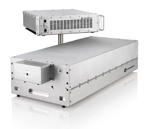3 April 2013
UV Fiber Laser Offers High Precision, High Throughput Processing
 Santa Clara, Calif., February 5, 2013 – A unique new ultraviolet fiber laser from Coherent, Inc. (Santa Clara, CA) (Nasdaq: COHR) offers the precision processing capabilities of a short-pulse, picosecond laser, together with the high throughput speed characteristic of a Q-switched, diode-pumped, solid-state laser. This is because the Daytona™ 355-20 delivers over 20W of power in sub-nanosecond pulses, at repetition rates of over 1 MHz (at 355 nm). In addition, the Daytona produces a TEM00 (M² <1.3) output beam, making it ideal for precision micromachining. Moreover, Daytona is a highly flexible platform that can be adjusted over a broad operating range to match the exact needs of a particular application. For example, pulsewidth can be adjusted from <1 ns to 20 ns, while repetition rate can go from single shot to over 2 MHz.
Santa Clara, Calif., February 5, 2013 – A unique new ultraviolet fiber laser from Coherent, Inc. (Santa Clara, CA) (Nasdaq: COHR) offers the precision processing capabilities of a short-pulse, picosecond laser, together with the high throughput speed characteristic of a Q-switched, diode-pumped, solid-state laser. This is because the Daytona™ 355-20 delivers over 20W of power in sub-nanosecond pulses, at repetition rates of over 1 MHz (at 355 nm). In addition, the Daytona produces a TEM00 (M² <1.3) output beam, making it ideal for precision micromachining. Moreover, Daytona is a highly flexible platform that can be adjusted over a broad operating range to match the exact needs of a particular application. For example, pulsewidth can be adjusted from <1 ns to 20 ns, while repetition rate can go from single shot to over 2 MHz.
The key to micromachining without peripheral thermal damage – a heat affected zone (HAZ) – is a short wavelength to drive cold photoablation and a short pulsewidth to limit thermal flow during this ablation. Traditional Q-switched UV lasers deliver pulsewidths of tens of nanoseconds creating an unacceptable HAZ in many applications. Until Daytona, the only alternative was to use lasers producing 10’s of picoseconds, but these did not have sufficient output power in the UV to support high throughput industries. Daytona is thus the first laser to deliver the optimum combination of precision and power for these applications.
Applications that can benefit from Daytona’s unique operating regime span high precision processing of a wide range of materials in high throughput applications. Specific examples include wafer dicing, scribing and drilling (especially with low κ materials), glass scribing for touch panels and LCDs, touch screen patterning, as well as thin film scribing for photovoltaics (solar) manufacturing.
- Contact Information
- Name: Victor David
- Email: victor.david@coherent.com
- Website: www.coherent.com

